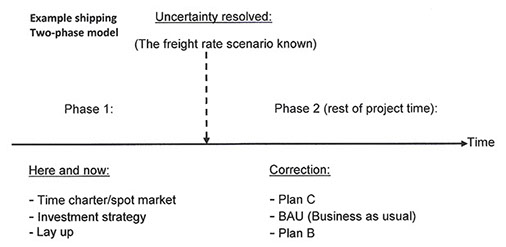WELCOME TO VIKING-INVEST
Risk management with real options - Real options the easy way
BERGEN NORWAY

REAL OPTIONS
Real options analysis (ROA) is the futures method for solving investment decisions dealing with real investments where uncertainty is a dominant element. Real options (RO) are characterized by a dynamic decision process, which includes operating (managerial) flexibility. The advantage of using RO is therefore clear; the operator can assess the value of flexibility and develop an investment strategy. ROA can evaluate the value of taking corrective action when market incidents occur, the operator can postpone operations, expand operations, scale down operations or abandon a project when new information is available. This makes the project more robust and is a form of risk management where the operator can limit downside risk and increase upside potential. To put it another way the operator can adapt to a new reality or event when new information is available, and can take corrective action such as a Plan B, Plan C or Plan D.
A DECISION MODEL FOR REAL OPTIONS ANALYSIS
Viking-Invest uses in most cases decision tree analysis (DTA) and this is implemented in a spreadsheet such as Excel at a low cost. In some cases we use DTA in combination with heuristic optimization and this is a more advanced model. Heuristic optimization is method where you search and find a solution and you are not guaranteed to find an optimal solution, but it’s sufficient to meet the objectives. The model helps the operator to choose the investment strategy that is in line with the operator’s risk-return profile. And since there is usually three scenarios after optimization this gives a clear risk-profile with “best”,” expected” and “worst –case” scenarios, where every scenario has a clear defined discrete probability. Traditional static expected net present value analysis does not capture the element of flexibility and is not dynamic, and therefore can’t be used to evaluate an investment strategy.
REAL OPTIONS THE EASY WAY
We use standard dynamic programming techniques or decision tree analysis (DTA) in some cases combined with heuristic optimization and therefore the slogan “real options the easy way”. We avoid complicated techniques such as contingent claims analysis (CCA) which are used in pricing derivatives in financial markets. CCA claims analysis has become popular methodology the recent years for calculating real options values and uses basically financial flexibility, whereas DTA uses operating flexibility, which is more appropriate when combining many types of operating flexibility.
OUR MODELS REAL INVESTMENT APPLICATIONS
- Factories, mines, shipping, production equipment, fish farming, hotels, shops, oil fields etc.
- Leasing versus owning issues, stage wise investments, investments characterized with flexibility etc.
VIKING-INVEST OFFERS
- Viking-Invest can offer courses where we work with the methodology and the model that is relevant (usually decision tree analysis or more sophisticated). The client will after the course be able to make his own decision model in a spreadsheet to evaluate an investment strategy. This is only possible if the client has the right skills and qualifications (see competence questionnaire). In case the client does not have the capabilities a course would be to extensive and Viking-Invest would have to make an investment analysis for the client. There are possibilities for support and follow-up after the course is done.
- Viking-Invest can offer real option and investment analysis for a project.
MODEL COST AND TWO-STAGE MODELS
A model is a formal description of facts from real life, but the main purpose is not to copy reality. The main purpose is to make a model that captures the fundamentals of the problem so that one can make an optimal or good decision. The model cost increases with how sophisticated the model is. In this context there therefor is a question of how sophisticated and how much effort one should put into a model. A two-phase investment analysis is a perfect compromise between low model cost and realism. With two phases one has 3 scenarios or outcomes after the optimization, something that makes the risk profile clear. By increasing the number of phases till 3, one makes a substantial leap in the model cost, because the number of scenarios increases drastically. With 3 phases one has typically 27 or more scenarios to deal with after optimization. This means that the risk situation becomes unclear, and as mentioned, the model cost and the workload in optimization increases substantially. In addition it becomes difficult to compare the risk between different projects in the same market segment with 3 or more phases. Another point is that only the decision in phase 1 is implemented and with adding more phases and more decisions, this may not improve the quality of the first decision substantially, since later decisions only serve as background for the first decision. If one should add 3 or more phases to the model, one could use the method stochastic dynamic programming (SDP).
